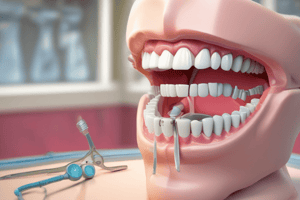Podcast
Questions and Answers
What is the general effect of digital sucking (finger/thumb) on oral habits?
What is the general effect of digital sucking (finger/thumb) on oral habits?
- Abnormal axial inclination of molars
- Increased saliva production
- Change in arch form (correct)
- Change in tongue position
At what age do most children stop thumb sucking?
At what age do most children stop thumb sucking?
- 6 years
- 5 years
- 2 years
- 3½ - 4 years (correct)
What is a common etiology for digital sucking (finger/thumb)?
What is a common etiology for digital sucking (finger/thumb)?
- Physiologic investigation of the mouth (correct)
- Imitation of adults
- Lack of exposure to other children
- Feeding problems due to tooth decay
What does 'intensity' refer to in the context of digital sucking?
What does 'intensity' refer to in the context of digital sucking?
Excessive sucking leading to damage is mainly caused by:
Excessive sucking leading to damage is mainly caused by:
Flashcards are hidden until you start studying
Study Notes
Digital Sucking (Finger/Thumb) and Oral Habits
- Digital sucking can negatively impact oral habits, leading to malocclusion and other oral health issues.
- Most children stop thumb sucking on their own by the age of 3-4 years old.
Etiology of Digital Sucking
- A common reason for digital sucking is as a self-soothing mechanism, often triggered by anxiety, stress, or boredom.
Intensity of Digital Sucking
- Intensity in the context of digital sucking refers to the frequency, duration, and force used while sucking the finger or thumb.
Consequences of Excessive Digital Sucking
- Excessive sucking leading to damage is mainly caused by the constant pressure on the teeth and surrounding tissues, which can result in misaligned teeth and other oral health problems.
Studying That Suits You
Use AI to generate personalized quizzes and flashcards to suit your learning preferences.


